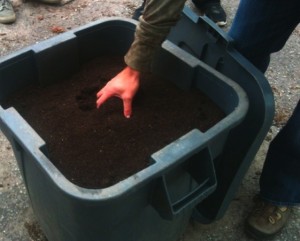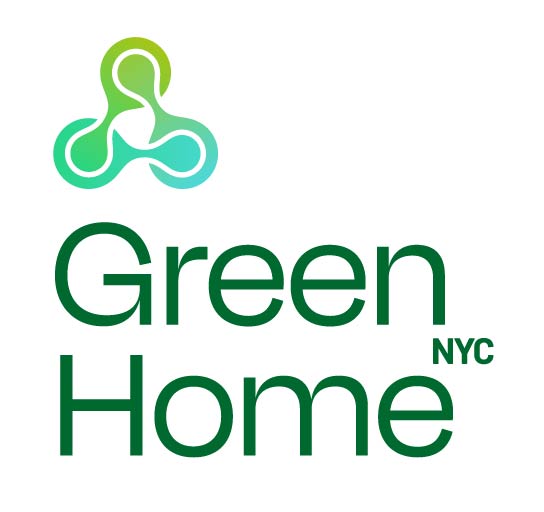
This year the Lower East Side Ecology Center will open its office and learning center at the East River Park Fireboat House.
The site will contain an aquarium connected to the river to prove that “there are actually things living in the East River.” Through initiatives such as environmental education programs, greening, and composting, The
Lower East Side Ecology Center works to promote a more sustainable New York City.
As part of
GreenHomeNYC’s SustaiNYC Spring tours, Daniel Tainow, Education Director, led a tour of three sites affiliated with LESEC.
On top of the Fireboat House is a Xero Flor Green Roof, made up of squares of sedum for insulation, absorption of rainwater, as well as other benefits of a green roof. “We will cut holes in the tower in order to install a spiral staircase that will make the green roof more accessible. This will also encourage passive air movement throughout the tower.” In the past the tower was used to hang hoses to dry after use. Solar ivy (tiny solar panels designed to mimic the appearance of ivy) will be hung to generate solar energy.
Switching gears from up towards the sun to down under the sea, LESEC also conducts oyster gardening in the East River. In collaboration with The New York Harbor School LESEC places baby oysters, or “spat”, in crates that are submerged in the river. “These aqua cultures create protected spaces for the oysters to grow to sizes at which they won’t be as vulnerable to predation. The oysters are then released out onto the reef by Governors Island.”
 “Plants are made up of about 90% water, which is high in nutrients. Through composting we can use our leftover fruits and vegetables to green neighborhoods.” LESEC collects food waste from the Union Square Greenmarket and from its community garden to turn it into compost by means of an in-vessel system and windrows. At the East River Compost Site Mr. Tainow explained the process of composting: First, nitrogen-rich compost is placed in plastic containers to be combined with sawdust, a carbon source that will help establish an ideal balance of air, moisture, and nutrients. The organic matter is then piled into windrows (long rows). “Worms digest microorganisms in the compost to produce worm castings, which provide plants with nutrients. LESEC is in the process of designing an artificial marsh to collect excess water and nutrients from the compost. ” A machine called a Bobcat turns the pile so that it is mixed and aerated. The compost is then placed into a screener, which removes the worms (returned to windrows) and any non-processed material to produce fine compost. “We also combine compost with coconut coir, or shredded coconut husk, to make potting soil. Coconut coir improves water and air movement throughout the compost.”
“Plants are made up of about 90% water, which is high in nutrients. Through composting we can use our leftover fruits and vegetables to green neighborhoods.” LESEC collects food waste from the Union Square Greenmarket and from its community garden to turn it into compost by means of an in-vessel system and windrows. At the East River Compost Site Mr. Tainow explained the process of composting: First, nitrogen-rich compost is placed in plastic containers to be combined with sawdust, a carbon source that will help establish an ideal balance of air, moisture, and nutrients. The organic matter is then piled into windrows (long rows). “Worms digest microorganisms in the compost to produce worm castings, which provide plants with nutrients. LESEC is in the process of designing an artificial marsh to collect excess water and nutrients from the compost. ” A machine called a Bobcat turns the pile so that it is mixed and aerated. The compost is then placed into a screener, which removes the worms (returned to windrows) and any non-processed material to produce fine compost. “We also combine compost with coconut coir, or shredded coconut husk, to make potting soil. Coconut coir improves water and air movement throughout the compost.”

Lastly, Mr. Tainow led us to Pier 42, “where the Lower East Side Ecology Center and the
Lower East Side Waterfront Alliance are working with selected artists, designers, and members of the community to provide temporary programming and amenities to the former working pier”. The Parks Department and the local Community Board are working on permanent plans to transform the pier into a green space. Features will include: rainwater harvesting, solar panels, channels for kayaking, and botanical drawings on the pavement.
Thank you to Mr. Tainow for leading a tour of these impressive sites. Whether through composting, preserving wildlife, or creating green spaces, it seems that there are numerous solutions for a more environmentally conscious and sustainable New York City.
 This year the Lower East Side Ecology Center will open its office and learning center at the East River Park Fireboat House.
The site will contain an aquarium connected to the river to prove that “there are actually things living in the East River.” Through initiatives such as environmental education programs, greening, and composting, The Lower East Side Ecology Center works to promote a more sustainable New York City.
As part of GreenHomeNYC’s SustaiNYC Spring tours, Daniel Tainow, Education Director, led a tour of three sites affiliated with LESEC.
On top of the Fireboat House is a Xero Flor Green Roof, made up of squares of sedum for insulation, absorption of rainwater, as well as other benefits of a green roof. “We will cut holes in the tower in order to install a spiral staircase that will make the green roof more accessible. This will also encourage passive air movement throughout the tower.” In the past the tower was used to hang hoses to dry after use. Solar ivy (tiny solar panels designed to mimic the appearance of ivy) will be hung to generate solar energy.
Switching gears from up towards the sun to down under the sea, LESEC also conducts oyster gardening in the East River. In collaboration with The New York Harbor School LESEC places baby oysters, or “spat”, in crates that are submerged in the river. “These aqua cultures create protected spaces for the oysters to grow to sizes at which they won’t be as vulnerable to predation. The oysters are then released out onto the reef by Governors Island.”
This year the Lower East Side Ecology Center will open its office and learning center at the East River Park Fireboat House.
The site will contain an aquarium connected to the river to prove that “there are actually things living in the East River.” Through initiatives such as environmental education programs, greening, and composting, The Lower East Side Ecology Center works to promote a more sustainable New York City.
As part of GreenHomeNYC’s SustaiNYC Spring tours, Daniel Tainow, Education Director, led a tour of three sites affiliated with LESEC.
On top of the Fireboat House is a Xero Flor Green Roof, made up of squares of sedum for insulation, absorption of rainwater, as well as other benefits of a green roof. “We will cut holes in the tower in order to install a spiral staircase that will make the green roof more accessible. This will also encourage passive air movement throughout the tower.” In the past the tower was used to hang hoses to dry after use. Solar ivy (tiny solar panels designed to mimic the appearance of ivy) will be hung to generate solar energy.
Switching gears from up towards the sun to down under the sea, LESEC also conducts oyster gardening in the East River. In collaboration with The New York Harbor School LESEC places baby oysters, or “spat”, in crates that are submerged in the river. “These aqua cultures create protected spaces for the oysters to grow to sizes at which they won’t be as vulnerable to predation. The oysters are then released out onto the reef by Governors Island.”
 “Plants are made up of about 90% water, which is high in nutrients. Through composting we can use our leftover fruits and vegetables to green neighborhoods.” LESEC collects food waste from the Union Square Greenmarket and from its community garden to turn it into compost by means of an in-vessel system and windrows. At the East River Compost Site Mr. Tainow explained the process of composting: First, nitrogen-rich compost is placed in plastic containers to be combined with sawdust, a carbon source that will help establish an ideal balance of air, moisture, and nutrients. The organic matter is then piled into windrows (long rows). “Worms digest microorganisms in the compost to produce worm castings, which provide plants with nutrients. LESEC is in the process of designing an artificial marsh to collect excess water and nutrients from the compost. ” A machine called a Bobcat turns the pile so that it is mixed and aerated. The compost is then placed into a screener, which removes the worms (returned to windrows) and any non-processed material to produce fine compost. “We also combine compost with coconut coir, or shredded coconut husk, to make potting soil. Coconut coir improves water and air movement throughout the compost.”
“Plants are made up of about 90% water, which is high in nutrients. Through composting we can use our leftover fruits and vegetables to green neighborhoods.” LESEC collects food waste from the Union Square Greenmarket and from its community garden to turn it into compost by means of an in-vessel system and windrows. At the East River Compost Site Mr. Tainow explained the process of composting: First, nitrogen-rich compost is placed in plastic containers to be combined with sawdust, a carbon source that will help establish an ideal balance of air, moisture, and nutrients. The organic matter is then piled into windrows (long rows). “Worms digest microorganisms in the compost to produce worm castings, which provide plants with nutrients. LESEC is in the process of designing an artificial marsh to collect excess water and nutrients from the compost. ” A machine called a Bobcat turns the pile so that it is mixed and aerated. The compost is then placed into a screener, which removes the worms (returned to windrows) and any non-processed material to produce fine compost. “We also combine compost with coconut coir, or shredded coconut husk, to make potting soil. Coconut coir improves water and air movement throughout the compost.”
 Lastly, Mr. Tainow led us to Pier 42, “where the Lower East Side Ecology Center and the Lower East Side Waterfront Alliance are working with selected artists, designers, and members of the community to provide temporary programming and amenities to the former working pier”. The Parks Department and the local Community Board are working on permanent plans to transform the pier into a green space. Features will include: rainwater harvesting, solar panels, channels for kayaking, and botanical drawings on the pavement.
Thank you to Mr. Tainow for leading a tour of these impressive sites. Whether through composting, preserving wildlife, or creating green spaces, it seems that there are numerous solutions for a more environmentally conscious and sustainable New York City.
Lastly, Mr. Tainow led us to Pier 42, “where the Lower East Side Ecology Center and the Lower East Side Waterfront Alliance are working with selected artists, designers, and members of the community to provide temporary programming and amenities to the former working pier”. The Parks Department and the local Community Board are working on permanent plans to transform the pier into a green space. Features will include: rainwater harvesting, solar panels, channels for kayaking, and botanical drawings on the pavement.
Thank you to Mr. Tainow for leading a tour of these impressive sites. Whether through composting, preserving wildlife, or creating green spaces, it seems that there are numerous solutions for a more environmentally conscious and sustainable New York City.

Leave a Reply
You must be logged in to post a comment.